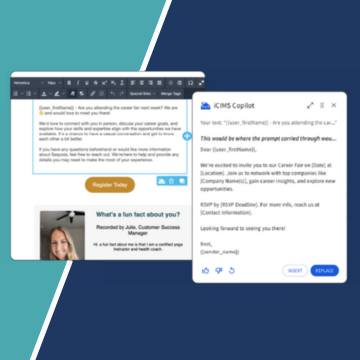- Solutions
- Products
- Community
- Resources
- Company
Create incredible candidate experiences that communicate your brand, mission, and values with recruitment marketing solutions.
Learn moreCommunicate effectively and efficiently with the candidates that can drive your business forward.
Learn moreSelect the right candidates to drive your business forward and simplify how you build winning, diverse teams.
Learn moreHelp your best internal talent connect to better opportunities and see new potential across your entire organization.
Learn moreCommunicate collectively with large groups of candidates and effectively tackle surges in hiring capacity.
Learn moreAccess tools that help your team create a more inclusive culture and propel your DEI program forward.
Learn moreRebound and respond to the new normal of retail with hiring systems that are agile enough to help you forge ahead.
Learn moreAccelerate the hiring of key talent to deliver point of care and support services that meet and exceed your promise of patient satisfaction.
Learn moreAttract and engage candidates with technical competencies, accelerate hiring for much-needed skills, and advance expertise within your valued workforce.
Learn moreSimplify how you recruit finance, insurance, and banking candidates with a unified platform built to match top talent with hard-to-fill roles.
Learn moreYour business strategy depends on your people strategy. Keep both in lockstep with the iCIMS Talent Cloud.
Learn moreBuild an engaging, high-converting talent pipeline that moves your business forward.
Learn moreDeliver the innovation your talent team needs, along with the global scale and security you demand.
Learn moreDeliver tailored technology experiences that delight users and power your talent transformation with the iCIMS Talent Cloud.
Learn moreThe #1 ATS in market share, our cloud-based recruiting software is built for both commercial and large, global employers.
Learn more Talk to salesAttract the best talent for your business with powerful, on-brand career websites that excite candidates and drive engagement.
Learn more Talk to salesCombine behavior-based marketing automation with AI insights to build talent pipelines, engage candidates with multi-channel marketing campaigns, and automatically surface the right talent for the job.
Learn more Talk to salesEmpower candidates with automated self-service, qualification screening, and interview scheduling through an AI-enabled digital assistant.
Learn more Talk to salesSimplify employee onboarding with automated processes that maximize engagement and accelerate productivity.
Learn more Talk to salesVerify skills with game-changing levels of automation and simplicity to improve the quality of hire at scale.
Learn more Talk to salesModernize, streamline, and accelerate your communication with candidates and employees.
Learn more Talk to salesTransform the talent experience by showcasing your authentic employer brand through employee-generated video testimonials.
Learn more Talk to salesSimplify recruiting, dynamically engage talent, and reduce hiring bias with job matching and recruiting chatbot technology.
Learn moreStreamline and centralize your HR tech stack with configurable, flexible, secure and reliable integrations.
Learn moreHow a beloved restaurant hires 40,000+ annually with a great candidate experience.
Learn moreThousands strong, our global community of talent professionals includes creatives, innovators, visionaries, and experts.
Learn moreTogether we’re creating the world’s largest ecosystem of integrated recruiting technologies.
Learn morePartner with our global professional services team to develop a winning strategy, build your team and manage change.
Learn moreExplore our network of more than 300 certified, trusted third-party service and advisory partners.
Learn moreUncover unique market insights, explore best practices and gain access to talent experts across out library of content.
Get resourcesExpert guidance about recruitment solutions, changes in the industry, and the future of talent.
Learn moreStay up to date with the latest terminology and verbiage in the HR software ecosystem.
Learn moreEmployers everywhere improve hiring efficiently and save money using iCIMS. Estimate the potential business value you can achieve.
Learn moreDive into the Class of 2023 Report highlighting this cohort’s expectations and where employers are willing — and able — to meet them.
Watch nowPartner with iCIMS to build the right strategies, processes, and experience to build a winning workforce.
Learn moreExpert guidance about recruitment solutions, changes in the industry, and the future of talent.
Learn moreDeliver the innovation your talent team needs, along with the global scale and security you demand.
Learn moreView press releases, media coverage, and the latest hiring data. See what analysts are saying about iCIMS.
Learn moreiCIMS is the Talent Cloud company that empowers organizations to attract, engage, hire, and advance the talent that builds a winning workforce.
Learn moreGet to know the award-winning leadership team shaping the future of the recruiting software industry.
Learn moreWe believe the future of work isn't something that "happens" to you. It's something you create. We actively create the future of work with our customers every day.
Learn moreiCIMS is committed to being a responsible and ethical corporate citizen, which is why Environmental, Social and Governance (ESG) initiatives are strategic imperatives.
Learn moreStreamline your tech stack and take advantage of a better user experience and stronger data governance with ADP and the iCIMS Talent Cloud.
Learn moreThe combined power of iCIMS and Infor helps organizations strategically align their business and talent objectives.
Learn moreOur award-winning partnership with Microsoft is grounded in a shared desire to transform the workplace and the hiring team experience.
Learn moreOur partnership with Ultimate Kronos Group (UKG) supports the entire talent lifecycle by bringing frictionless recruiting solutions to UKG Pro Onboarding.
Learn moreLet’s get in touch. Reach out to learn more about iCIMS products and services.
Learn more

As a remote worker during the COVID-19 pandemic, I’ve had my fair share of awkward video conference calls. Barking dogs, a crying kid, and the most cringe-worthy of all is being exposed in my “mom uniform.” You know, black leggings and a lot of oversized sweaters.
Mackenzie Egan, talent development trainer at iCIMS, had a different challenge. Due to the spread of COVID-19 and new CDC guidelines, she had less than a week’s notice to take our company’s award-winning onboarding program and make it remote-ready. An effective remote onboarding program assimilates new hires into the organization’s culture in a virtual environment, despite location and time zone barriers. Not an easy task.
iCIMS is not alone in this situation, of course. Many organizations are facing similar challenges, as they are forced to adapt their hiring processes as social distancing drags on: Yelp cancelled their internship program, while Uber is going virtual.
With the help of passionate and willing stakeholders, Mackenzie managed to overcome technical fears and cringe-worthy awkward silences to bring together a diverse group of now-remote new hires.
I remember my time with Mackenzie as a new hire so vividly. Her in-person sessions are welcoming and warm, putting new employees quickly at ease. My first question to her now: How do you translate that emotion and our unique company culture over a video call?
“I’m more exhausted now than if I was in front of a classroom because you want to make the session even more engaging,” Mackenzie confessed.
She and the entire team learned quickly that they could do most of their trainings remotely, whether they were self-led or instructor-led. It isn’t a one-to-one replacement when it comes to face-to-face engagement, but they feel pretty good about how fast they were able to pull it off.
But let’s rewind back to when Mackenzie first got the call that she had to quickly put together an entirely remote onboarding class.
Every new iCIMS employee is handed a 90-day boarding pass that outlines their training sessions. Mackenzie developed an addendum for new hires to easily access the Zoom meetings and offered alternative training sessions for different time zones. But, regardless of geography, “they all chose to be online together, which was really nice,” she said.
Mackenzie also pulled in the Information Security Systems team to quickly put together tech packets, including login credentials, and have them quickly shipped out to each new hire’s remote location.
Access to new hire paperwork, including electronic I-9 forms, was given through the iCIMS Preboard onboarding portal. Due to the restrictions of social distancing, the Department of Homeland Security now permits flexibility surrounding the requirement to “physically inspect” documents. The iCIMS HR team used Zoom to virtually inspect the new hire class’ paperwork. (Note: as soon as normal operations resume, employers are expected to physically inspect documents.)
Hiring managers were tasked with important to-dos through the onboarding portal, with objective setting and 90-day plans, because even (and especially) during times of social distancing, business objectives must be met. More on how to do that here.
Mackenzie also tapped hiring managers for culture-building tasks such as a shoutout on the company’s social network.
For the first few days of onboarding, Mackenzie adjusted the schedule to offer more 15-minute breaks for the group than what is the norm for a classroom setting. She noted herself that working remote means she’s not actively getting up from her computer, so she was cognizant of giving that breathing room to the new hires. In Mackenzie‘s words, she “added a bit more TLC” to the agenda.
Breakout rooms were developed for some exercises so remote new hires could speak to one another without the room hearing. During the group sessions, Mackenzie leaned on additional HR team members to help dial-in guest speakers. The only rule for all involved? They had to turn on their video for that face-to-face interaction.
Jason Epner, sales executive at iCIMS, went through sales onboarding this way and after years of working remotely he agreed with Mackenzie’s video rule.
“I’ve done more video conferencing lately than anywhere else,” said Jason. “To have the face-to-face makes it feel a little more like home.”
It is an iCIMS tradition that new hires eat lunch with their hiring manager the first day. I had to ask – did they eat lunch over video?!
“That’s a great question,” laughed Mackenzie. “With a typical onboarding schedule, managers feel that the new hires are ‘untouchable’ for the first few days. But in this situation, we actually built in a break at the end of the day for the managers to connect with their new team members.”
Managers spent the time talking to their hires about what they’re learning and what they were excited to hear more about in the sessions. (Thankfully for all they skipped eating on camera.) The onboarding portal included videos from iCIMS executives about the company’s history and core competencies.
Throughout the first week of onboarding, Mackenzie creatively transformed well-known iCIMS icebreakers into remote-ready fun.
Her favorite ones? A virtual show-and-tell and a virtual scavenger hunt. She admitted that these required a lot of upfront work and more prep than usual – but it was worth it.
With the show-and tell, many of the new hires were able to show off their personalities (one was an antiques collector) and even some of their tiniest co-workers.
“I had my chocolate lab Marley jump up!” laughed Sharon Lubrano, iCIMS’ new vice president of demand generation who was part of Mackenzie’s remote onboarding class. Sharon found that this icebreaker helped bond the new hire class in a different way, with one of the members even sharing a “good luck with your new job” note from his daughter.


Marley the chocolate lab makes a guest appearance during video onboarding with his human, Sharon Lubrano, iCIMS’ new vice president of demand generation.
But what followed the virtual show-and-tell was the real showstopper: a scavenger hunt. Typically, this is about the new employees getting the lay of the land across the four floors of the office building and out into our campus HQ at Bell Works. Find the big conference rooms, meet some new team members, and even stop by the food market. Instead, the virtual hunt was aimed at helping new hires discover essential online resources, from the internal communications portal to the tech help ticketing system. Mackenzie is going to add this exercise to the onboarding curriculum moving forward – whether they’re in the classroom or remote.
Nicole Conti, marketing analyst at iCIMS, was part of the new hire class and noted that constant communication was key.
“It was an open and engaging environment and by the end of [onboarding] I definitely felt like I had a good foundation,” said Conti.
“[The virtual environment] forces connection,” said Mackenzie. “And for our team, it has actually sparked a lot of new ideas.”
Are you at a standstill for how to best onboard your new hires? Read below for more tips from Mackenzie on how to make remote onboarding a success.
Learn how to help create an exceptional new hire experience to boost employee productivity. Download our guide, Make Onboarding Your Competitive Advantage, below.





